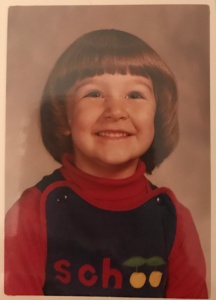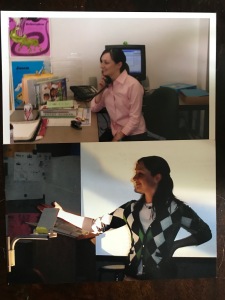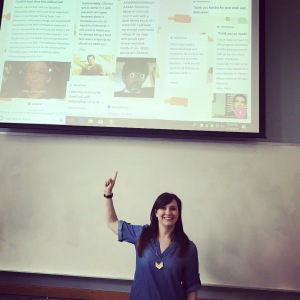TEACHING PHILOSOPHY
Composition 2.0 is a “movement defined by its iterative, collaborative, and participatory approach to composing and working with information” (Day, McClure, Palmquist). Composition 2.0 is not a matter of whether or not to incorporate technology in the classroom, but how and in what ways. As a writing instructor in the 21st century, I see it as my duty and my privilege to create a space for my students to explore, to fail, to tinker, and to expand their notions of technology use as both communication and a meaning making process
Composition 2.0 in My Classroom
In my composition courses as well as my upper level course on Writing Theory and the Writing Process, I give students tinkering possibilities for assignments; I do not dictate product. I want my students to make informed decisions on what media will best deliver their message. For example, after discussing the topic for a couple weeks, I had my students write an extended definition of multimodality. Those students who focused on how social media relies on multimodality created their definition through an Instagram story or a series of Tweets. Those students who described how writing has always been multimodal created their definition as comics or a children’s book. By not having strict parameters, I have found their work to be more creative, more thoughtful, and more rhetorically sound.
I also recognize that if I want my students to not only buy into digital writing, but really value it, then I have to show them that I value it as well. I don’t simply talk about the value of digital writing, but I enact it too. Living a digital life as a teacher means that I am communicating with them on their blogs (and keeping one of my own), I am creating a writer website along with them, I digitally create important course documents (like their syllabus) as a digital text, and I incorporate digital media as well as digital composition every day that we are in the class. Please see examples of my digital course documents and pedagogy on my website: kendralandrews.com.
Students are often nervous to approach the digital space with the messiness, experimental nature, and revision that technological work must require. Although it can be a messy process (and one that often creates frustration), students become the authority of their work because they went through the labor of it and they made their own choices. I tell my students who are working on digital or multimodal projects with a critical or rhetorical framework of production for the first time that if they aren’t frustrated or challenged by their process, then they need to start over. We only learn when we move out of what we already know. With multimodal composing and technological literacy practices, there are new possibilities for invention. No longer is the composer locked into a stasis paradigm with a linear model for thinking, composing in multiple ways can create a choric space for invention where the composer can revel in the messiness of thought and new composing experiences.
Continuity and Change as a Teacher
I knew that I was going to be a teacher by the age of four. While my areas of focus may have changed over the years, I continued in my passion as an educator. Although the levels or areas have changed, I have kept my main principles as a teacher: to find something that each student is passionate about and can excel in, to serve as a safe space for students to discuss issues of importance to them, and to create possibilities to bring what they do in the classroom to the world outside. These principles are always my guide, but I think that a teacher needs to be willing to shift and change to keep learning how to best approach her classroom.
Download Teaching Philosophy 2.0
Once a Teacher, Always a Teacher
 Growing up, I had an active imagination and a few siblings to play with me, whether they wanted to or not. I remember that playing “school” was one of my favorite things to do.
Growing up, I had an active imagination and a few siblings to play with me, whether they wanted to or not. I remember that playing “school” was one of my favorite things to do.
I would often enlist my younger brother and sister to play with me and I would set up lesson plans and activities for them to do. I made them sit at desks where I had them actually advance through different materials or work on their reading. One of my favorite things to assign was a writing activity that I explained and then wrote their assignment on a large chalkboard: they would be writing an “S.A.” At eight or nine, I didn’t know how to spell “essay,” but I did recognize the importance of writing in education.
NC Teaching Fellow and UNC Chapel Hill
Since then, I have never wavered that I was going to be a teacher. I officially started working in classrooms in 1998 when I began my work as a Teaching Fellow at UNC Chapel Hill. Through that four year scholarship and education program, I have worked as a student teacher in elementary and middle school classrooms, worked with ESL students, and took intensive classes on classroom pedagogies. After I earned my BA, I moved into my Masters of Teaching where I focused on English as a second language, then shifted my focus to Secondary English and took nearly a undergraduate major’s worth of English courses, and ultimately graduated with a MAT in English.
Teaching High School
 Many people have asked me why I left high school to teach at the college level when I loved teaching high school so much. Honestly, I don’t have a good answer. Teaching high school let me work with students for years at a time, which created greater trust and stronger relationships, and it made me feel like I had a greater impact on students. I taught freshman, sophomore, and senior English at all levels, was the journalism teacher and advisor, developed and taught a course on mythology, and worked as the JV Head Soccer Coach. During my time at Cedar Ridge High School, I worked with intelligent and innovative faculty who cared as much about their students as I did–the students became part of our greater family. Even though I left almost a decade ago, I still keep in touch with my teacher friends and many of my students to this day.
Many people have asked me why I left high school to teach at the college level when I loved teaching high school so much. Honestly, I don’t have a good answer. Teaching high school let me work with students for years at a time, which created greater trust and stronger relationships, and it made me feel like I had a greater impact on students. I taught freshman, sophomore, and senior English at all levels, was the journalism teacher and advisor, developed and taught a course on mythology, and worked as the JV Head Soccer Coach. During my time at Cedar Ridge High School, I worked with intelligent and innovative faculty who cared as much about their students as I did–the students became part of our greater family. Even though I left almost a decade ago, I still keep in touch with my teacher friends and many of my students to this day.
Teaching in the University
After five years teaching at the secondary level, I decided to earn another MA in English with a Rhetoric and Composition focus, and subsequently began my career teaching composition at the university level. I worked in the writing program at UNC Charlotte for four years before moving to NC State University to earn my PhD in Communication, Rhetoric, and Digital Media with a focus on critical digital pedagogy. While earning my doctorate, I worked in the First Year Writing Program as a teacher and a Graduate Assistant Director (junior WPA) for two years.
 While serving as a WPA, I was not allowed to teach during the academic year so I could focus on administration, but I had a hard time giving up the magic of the classroom. In order to get my teaching time in, I worked as a mentor to new PhD students working in the FYW program as well as the English MA students teaching for the first time ever. I also co-taught three courses with Chris Anson, two of those courses were graduate level (Composition Theory and History and Writing Program Administration) and the third course was an upper level English major course (Writing Theory and the Writing Process) that I am also taught on my own. During the summers and during my first spring semester, I taught an upper level writing course for students in other disciplines (Communication for Engineering and Technology) four times. I also co-taught another graduate course in the spring with Chris Anson (Empirical Research in the Field of Composition).
While serving as a WPA, I was not allowed to teach during the academic year so I could focus on administration, but I had a hard time giving up the magic of the classroom. In order to get my teaching time in, I worked as a mentor to new PhD students working in the FYW program as well as the English MA students teaching for the first time ever. I also co-taught three courses with Chris Anson, two of those courses were graduate level (Composition Theory and History and Writing Program Administration) and the third course was an upper level English major course (Writing Theory and the Writing Process) that I am also taught on my own. During the summers and during my first spring semester, I taught an upper level writing course for students in other disciplines (Communication for Engineering and Technology) four times. I also co-taught another graduate course in the spring with Chris Anson (Empirical Research in the Field of Composition).
In addition to teaching, I served as a Research Assistant in the Campus Writing & Speaking Program at NC State under Chris Anson and worked with faculty across the university to integrate more writing into their curriculum. I have also worked with faculty and students on peer review specifically in upper-level STEM courses.
Following my work at NC State, I moved to Fairfield, CT and taught First-Year Writing Classes at Fairfield University. Within the Core Writing Program, I taught courses that focused on rhetoric and composition through the development of threshold concepts. In addition to my work within First-Year Writing, I served as a WAC Consultant for the university and assisted faculty across the disciplines with the integration of writing in their courses. Specifically, I aided faculty in the application of digital pedagogy with writing in courses across the disciplines (some of my work can be be seen in the development of a faculty website on technology and writing integration).
Most recently, I began my work in the Writing Program at Wake Forest University where I serve as an Assistant Teaching Professor. In this position, I teach First-Year Writing courses as well as advanced writing courses and courses within the Interdisciplinary Writing minor.